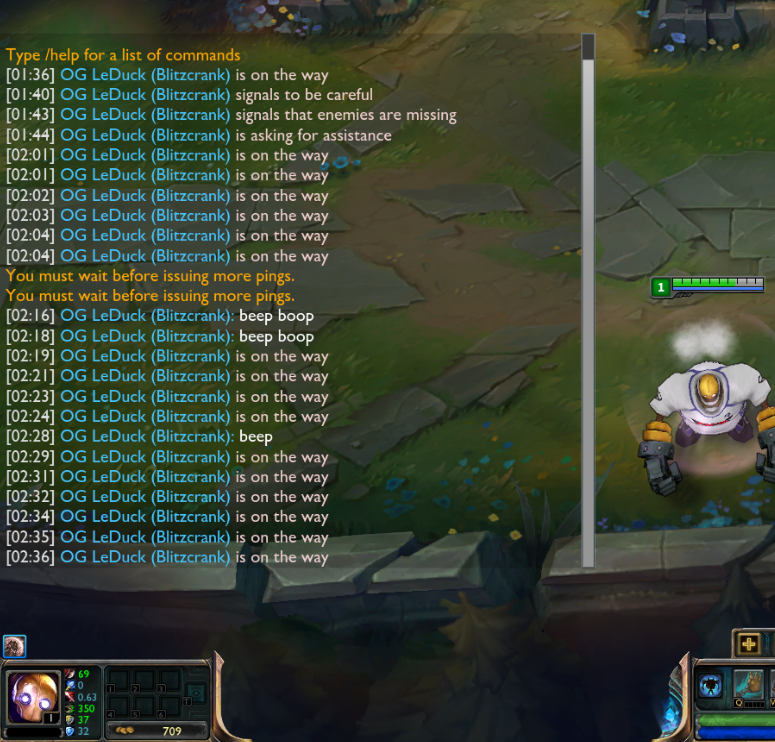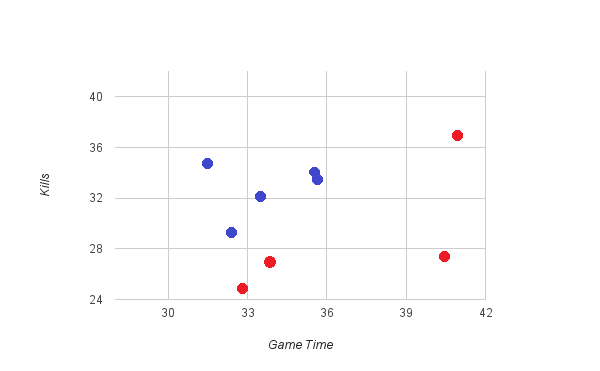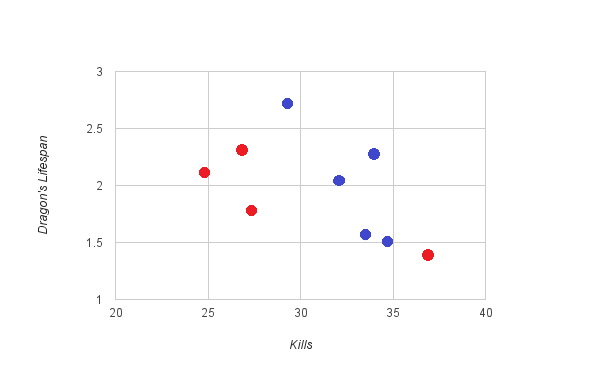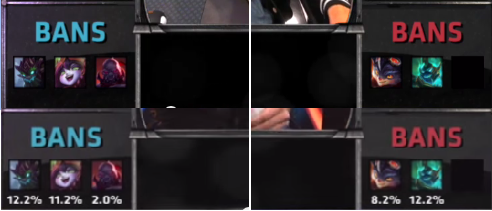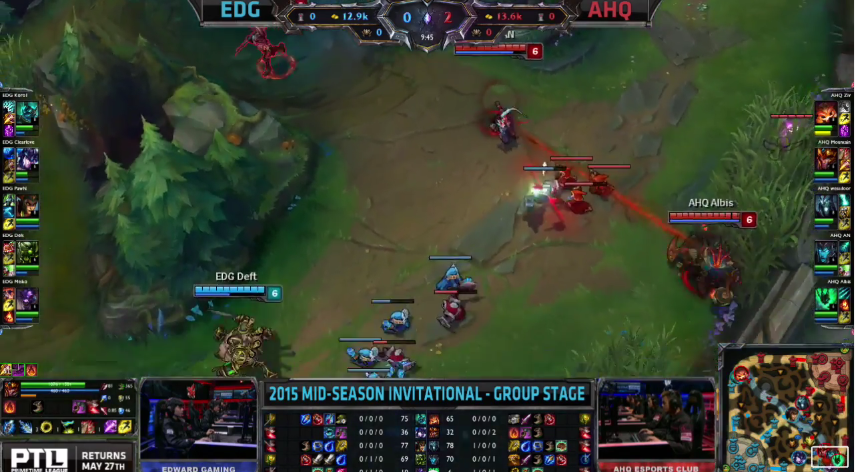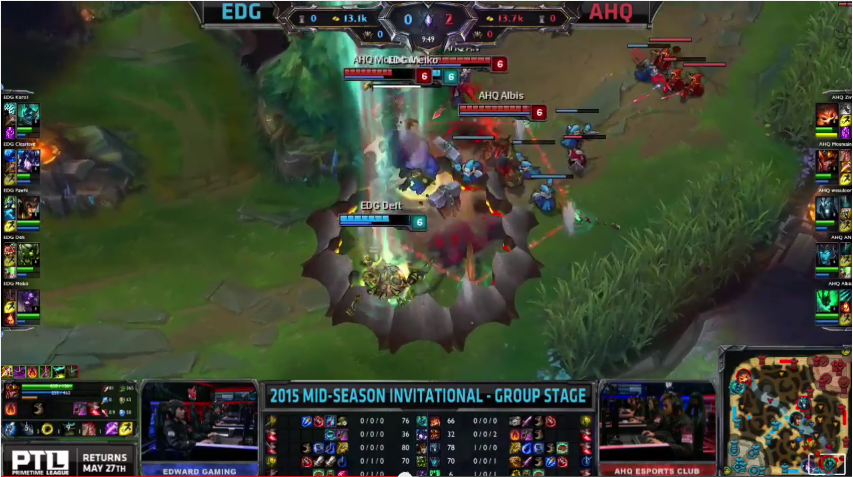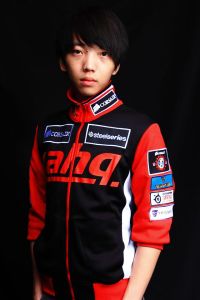The Team
Fnatic’s roster underwent a total makeover this offseason in the wake of their runner-up finish in 2014 LCS Summer Split and disappointing group stage exit at the World Championship. Star midlaner xPeke and jungler Cyanide, the last remaining members of the Season 1 World Champion team, departed for a new team and retirement, respectively. Top laner SoAZ joined xPeke’s nascent Origen squad, and AD Carry Rekkles left for the disappointing new Elements superteam. The sole remaining player, support Yellowstar, scoured the Korean leagues and EU Challenger scene for replacement players who would fit his vision of a new, modern Fnatic. The result was this Spring Championship squad, a team characterized by early support roams and top lane focus. FNC will no doubt be considered an underdog at the MSI, but people have been underestimating this team all season, only to see them emerge at the top of the heap.
The Players
Top – Heo “Huni” Seung-hoon
Key Champions – Rumble Vladimir Lee Sin
Fnatic grabbed Huni, the spring “Rookie of the Split,” from the deep ranks of the Korean Samsung organization to man their vacant top lane spot. Huni responded by tying for the league lead in top laner kills while placing third at his position in deaths. Huni is never afraid to get into the fray for his team, and paired with jungler Reignover, Huni relentlessly carved a path through the enemy with his aoe mages and off-tanks. Unlike top laners from other regions, Huni made almost no effort to switch to a super tanky playstyle post-5.5, at most picking up Hecarim when available and a surprise Lee Sin in the EU semi-finals. Instead, he continued to play his front line mages, complementing a fearsome Rumble with a dangerous Vladimir. Huni’s most outstanding quality is his dynamic teamplay. Not only is he Fnatic’s most dangerous early skirmisher, Fnatic’s lategame teamfights look completely different when Huni is involved; while everyone else on the team has a set role, Huni bounces around between front and backline, drawing focus then leaving. His masterful orchestration often leaves enemy teams out of position and vulnerable, even when they actually manage to take Huni out.
Jungle – Kim “ReignOver” Yeu-jin
Key Champions – Rek’Sai Olaf Rengar
Like Huni, Reignover led all EU players at his position in kills, and, like Huni, was third in deaths, behind the junglers from the hapless CW and Giants Gaming squads. Another Korean import, Reignover teamed with his top lane countryman to form a powerful skirmishing duo; they combined for dozens of ganks and double roams during the season. Reignover is highly aggressive, yet it always seems calculated; his ganks have a high rate of success both because he correctly gauges where to go, but also because he has an intuitive feel for how much damage he and his teammates can output and tank. He also shows an outstanding ability to come at his opponents from surprising angles at all times in the game, especially on Rek’Sai and his signature Rengar. As the game goes on, Fnatic uses Reignover to initiate skirmishes and occupy the enemy while the rest of his team uses the space he creates to pick the opposing team apart. Reignover was extremely useful on his proprietary Olaf for this reason. Even though he died more often than he got kills, his ability to run unimpeded at the enemy made the situation extremely uncomfortable for his opponents, and the rest of his team capitalized on that discomfort. Lately Reignover has had some success on the tanky junglers of the post-5.5 landscape, but he still looks most comfortable on his favored carries.
Mid – Fabian “Febiven” Diepstraten
Key Champions – Zed Leblanc Ahri
Febiven mixes in some Ahri, Kassadin, Twisted Fate and Cho’gath when his main assassins are banned or taken, but he is on an entirely different level with Zed and Leblanc. Part of the reason for this is that they are best suited for his farm and flank split pushing style, but even more important is that they are the most potent “safe” assassins. Febiven is best when he has the tools not only to get in but also out of fights. Even if he does not drop his full payload of damage right away, he is incredibly smart about how to distract and frighten the opponent into a mistake that he or his teammates can use. He is always willing to commit to a winning fight, but even more important is that he always gives himself a way out if the fight goes wrong, and he has the discipline to use that way out. It makes for a dangerous threat on his opponents’ flanks that can never be easily disposed. Overall, Febiven is not the most individually skilled player, nor does he have the deepest champion pool, but he meshes so well with his teammates that it rarely matters.
AD Carry – Pierre “Steeelback” Medjaldi
Key Champions – Everyone
Steeelback is the chameleon of Fnatic, playing whichever champions his team needs and safely doing damage from the back while his teammates make plays. He began the season playing the popular caster-type carries like Graves and Corki, and has lately branched to such varied choices as: hypercarries like Jinx, teamfighters like Sivir, midrange carries like Lucian, and even the occasional supersafe farming Ezreal. Steeelback often falls behind in lane, in part because of mediocre 2v2 laning but also because he is left alone by the roaming of his teammates. However he is prodigiously successful at safely doing damage in fights, as evidenced by his 95 spring split kills compared to only 27 deaths. While his more aggressive teammates are distracting the enemies, Steeelback acts as the fist in the glove, cleaning up the fights and staying alive to push towers.
Support – Bora “YellOwStaR” Kim
Key Champions – Thresh Nautilus Janna
YellOwStaR is Fnatic’s engine. Long before the rest of EU fully understood lane swaps and roaming supports, YellOwStaR was modernizing the European game. Initially on his powerful Annie, but lately on higher utility supports like Janna, Nautilus and especially Thresh, YellOwStaR is Fnatic’s chief playmaker. Not only is YellOwStar superb at using his champion’s skills perfectly in chaotic teamfights, he also is a tremendous in-fight decision-maker, masterfully conducting his teammates in and out of the battle. This is especially apparent on Thresh, as his teammates instantaneously make plays with the knowledge that they will be getting a perfectly timed lantern to escape. YellOwStaR’s glaring weakness is, like Steeelback, his mediocre 2v2 laning. Teams can set him back or at least draw Reignover’s help by setting up 2v2 lanes, and Fnatic often does not work hard enough to get early lane swaps.
Picks and Bans
During the regular season, Fnatic generally banned a mix of their opponents’ best champions, then picked for themselves champions that fit their own style. This seemingly straightforward pick/ban phase usually resulted in an aoe mage toplaner, a mobile carry jungler, an assassin mid, and a roaming support. In the playoffs however, the extent to which home preparation played a role in Fnatic’s pick/ban phase was readily evident; in both series they banned the same three or four champions every game, rather than adjusting to what their opponent showed them. They had a clear gameplan; they would limit their opponent’s access to strong champions like Maokai that they themselves did not play. In their early picks, they prioritized a favored support for YellOwStaR or extremely high overall priority champions like Sivir or Hecarim, leaving a late pick for Febiven to try to counterpick his lane. Fnatic’s picks were based on making sure each player had a strong champion on which he was comfortable, rather than going for a thematic team composition or trying to outpick their opponents. This is a perfect style for them, as their comparative lack of pick/ban creativity increases their ability to catch their opponents off-guard with creative play in the actual game.
Playstyle
Among European teams, Fnatic has the most modern approach to League of Legends, in that they consistently try to maximize their resources with smart rotational play instead of stagnant orthodoxy. As long as Fnatic’s mid and AD carry have a regular stream of lane gold, everyone else is flexibly arranged where they can have the greatest impact. While most teams who play this way early eventually settle into a more settled midgame style, Fnatic continues to roam and fight through the entire game. Though they are happy to simply take free towers or dragons when offered, Fnatic’s greatest strength is their ability to quickly collapse as a team on stragglers or poorly positioned champions.
Alone among MSI teams, Fnatic’s early game is a breath of fresh air. In an era of defensive river control and counterinvades, Fnatic often tries some goofball way to grab early initiative, whether by camping a lane brush, a 4-man tribush invade, or some other wonky tactic. They are not afraid to sneak a 3-buff start, and they have a deep understanding of their champions’ early game strengths and how to use them. Fnatic’s early game hijinks can backfire though, even if they do not give up kills, since spending so much time in the jungle can create strange strength imbalances compared to enemies who have spent that time in lane. However, it is extremely rare for Fnatic to be significantly behind in gold after the early phases of the game, and relatively common for them to be moderately ahead.
A common theme of Fnatic’s early midgame is Reignover and Huni making plays in lane together, either in the 1v1 top lane or by roaming to the duo lane. Fnatic works very hard to get a tower, often trading very early, which frees YellOwStaR to roam around the map while their mid and bot carries farm to relevance. Then, throughout the game, Fnatic works hard to create a weakness in their opponent’s setup, usually their top laner, and relentlessly pressure that weakness until their opponent cracks. On one hand, it can result into multiple teamfights that are essentially 4v5 because one champion is so far behind, but on the other hand, Fnatic is sometimes far too reckless in trading renewable resources like kills for less renewable resources like dragons and towers. As a result, Fnatic can struggle to close out games, having neither the dragons nor the map control to decisively strike at their opponent’s heart. They overly rely on auspicious fights and barons to win the game.
Player to Watch
YellOwStaR
Fnatic’s support will be under a lot of pressure this tournament, not only because of his relatively weak laning and his international counterparts’ great roaming, but also because as captain and shotcaller, he will have the responsibility of making sure Fnatic can initiate the complications that make them successful . Fnatic is likely to struggle if they cannot initiate and sustain their frenetic chaotic style from first blood until the nexus dies, and YellOwStaR is the key orchestrator of that style.
Key Number – 349
That’s Fnatic’s EU-leading kill total during the spring split, ahead of SK’s second-largest total by over 60. They managed that compared to only 231 deaths, meaning that FNC was consistently initiating and dominating teamfights and skirmishes. The flip side is that their 34 total dragons were ahead of only two teams — cellar-dwellars MYM and Giants Gaming — and that total was nearly doubled by SK. FNC was majorly reliant on initiating good teamfights in strange places to win the game, and it is unclear if they can adjust to a disciplined team that fights for objectives and vision control.
Outlook
It seems like Fnatic’s style should have been figured out long ago. They fight early and often, and they turn those fights into towers and barons. A smart team need only avoid those fights and keep FNC on track to hamstring them. It is thus a testament to how brilliantly Fnatic implements that style, with teamwork and preparation, that they could keep it up for a whole split and emerge victorious. So as much as it seems self-evident that Fnatic will run out of steam against the best in the world, FNC always manages to beat the odds, especially when the stakes are highest. Watch for Fnatic to catch unwary opponents off guard at the beginning of the tournament and then continue to surprise throughout the event, maybe even sneaking their way onto the podium by the end of it all.







